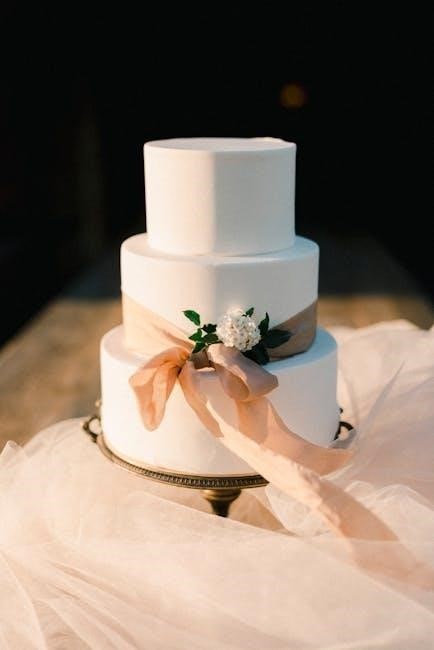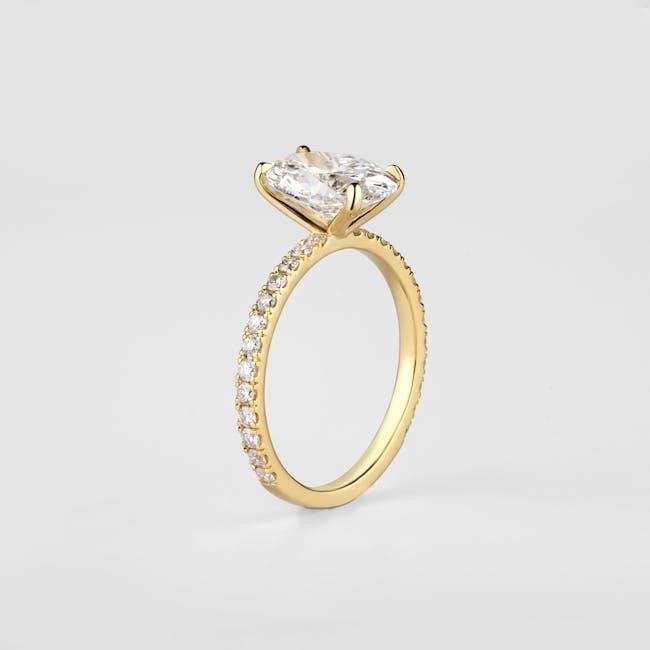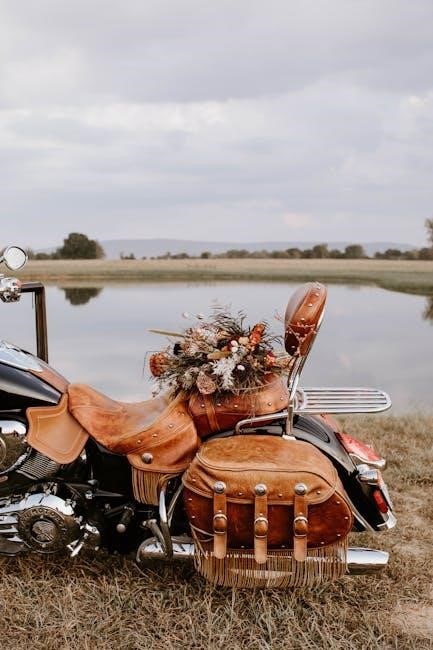Choosing the right wedding band width is essential for both aesthetics and comfort. This guide helps you understand the importance of band width in selecting the perfect ring.
Understanding the Importance of Band Width in Wedding Rings
Band width plays a crucial role in both the comfort and style of wedding rings. A wider band offers durability and a bold aesthetic, while a narrower band provides a sleek, minimalist look. The right width ensures a proper fit, complementing finger size and shape. It also impacts practicality, as thicker bands may not suit active lifestyles. Additionally, band width influences the ring’s visual appeal, with wider bands making fingers appear shorter and narrower bands elongating them. Choosing the ideal width balances personal style, comfort, and functionality, ensuring the ring is both beautiful and wearable for years to come.

Basics of Wedding Band Width
Wedding band width refers to the ring’s thickness and the distance it covers on the finger. It ranges from 2mm to 8mm, with standard widths varying by gender and style.
What is Wedding Band Width and How is It Measured?
Wedding band width measures the ring’s thickness and the distance it spans on the finger. It is typically measured in millimeters, ranging from 2mm to 8mm. The width is determined by the band’s vertical dimension, not its circumference. To measure, place the ring on a calibrated ruler or use a jeweler’s gauge. Proper measurement ensures a comfortable fit and aligns with personal style preferences. Accurate sizing is crucial for both durability and aesthetic appeal, making it a key factor in selecting the perfect wedding band.
Ring Thickness vs. Band Width: Key Differences
Ring thickness refers to the vertical measurement of the band, while width denotes the horizontal span on the finger. Thickness affects durability and comfort, with thicker rings being sturdier. Band width impacts style and finger appearance, wider bands emphasizing presence. While both are important, they are distinct measurements. Understanding their differences helps in selecting a ring that balances aesthetics and practicality. Proper proportions ensure a comfortable fit and enhance the overall design of the wedding band.

Factors to Consider When Choosing a Wedding Band Width
Finger size, shape, and personal style influence band width choices. Comfort and practicality are key, ensuring the ring fits seamlessly with daily wear and other jewelry.
How Finger Size and Shape Influence Band Width
Finger size and shape significantly impact the choice of wedding band width. For smaller fingers, narrower bands (2-4mm) create a balanced look, while larger fingers can accommodate wider styles (6-8mm). The shape of the finger also matters; for example, those with shorter fingers may prefer thinner bands to elongate their appearance, whereas thicker bands can complement longer fingers. Additionally, the fit must be comfortable to ensure the ring slides over the knuckle easily. Considering these factors ensures the band enhances the finger’s natural appearance while providing lasting comfort.

Personal Style and Aesthetic Preferences
Personal style and aesthetic preferences play a crucial role in selecting a wedding band width. For those who favor minimalism, narrower bands (2-4mm) offer a sleek, understated look, pairing seamlessly with other rings. Conversely, individuals drawn to bold statements may opt for wider bands (6-8mm) that stand out. The choice also aligns with engagement ring styles, ensuring a cohesive look. Some prefer a matching band width for a uniform appearance, while others mix styles for a personalized touch. Ultimately, the band width should reflect the wearer’s taste, blending seamlessly into their daily style and jewelry collection. Comfort and compatibility are key considerations.
Comfort and Practicality in Daily Wear
Comfort and practicality are vital when choosing a wedding band width. Narrower bands (2-4mm) are ideal for smaller fingers or active individuals, ensuring ease of movement. Wider bands (6-8mm) may feel cumbersome for those with larger knuckles or hands. Consider your lifestyle and occupation; for example, professionals with manual labor jobs may prefer thinner bands for better dexterity. Ultimately, the band width should balance style with comfort, ensuring it feels natural for daily wear without causing discomfort or hindrance. Prioritizing practicality ensures your wedding band remains a joy to wear for years to come, complementing your active lifestyle seamlessly.

Standard Wedding Band Widths for Men and Women
Men’s wedding bands typically range from 4mm to 6mm, while women’s bands are narrower, usually 2mm to 4mm, reflecting traditional preferences for comfort and style.
Common Widths for Men’s Wedding Bands
Men’s wedding bands typically range in width from 4mm to 6mm, with 5mm being a popular choice for most. Wider bands, such as 7mm or 8mm, are preferred by men with larger fingers or those who favor a bold look. Narrower options, like 3mm or 4mm, are ideal for a sleek, minimalist style. Comfort and durability are key factors, as wider bands may feel heavier but are often more robust. Ultimately, the choice depends on personal preference, finger size, and lifestyle, ensuring the ring is both stylish and practical for daily wear.
Popular Widths for Women’s Wedding Bands

Women’s wedding bands commonly range in width from 2mm to 4mm, with 2mm being a delicate, minimalist choice and 4mm offering a slightly bolder look. Some women prefer narrower bands to complement an engagement ring, while others opt for wider styles for a more substantial appearance. Comfort and personal style play a significant role in selecting the ideal width, as wider bands may feel heavier but can also provide a striking visual contrast. Ultimately, the choice depends on individual preferences, finger size, and whether the band will be worn alone or stacked with other rings.
Average Ring Widths Based on Finger Size
Finger size significantly influences the choice of wedding band width. For smaller fingers (size 4-6), narrower widths (2-3mm) are often preferred for a balanced look. Medium-sized fingers (size 7-8) typically suit widths between 3-5mm, offering a classic appearance. Larger fingers (size 9 and above) may look better with wider bands (5-7mm) to maintain proportion. Ultimately, the goal is to ensure the ring complements the finger without feeling overwhelming. While these are general guidelines, personal comfort and style should always be considered for the perfect fit.
How to Choose the Right Band Width for Your Engagement Ring
Selecting the perfect band width involves balancing finger size, personal style, and engagement ring proportions. Try on different widths to ensure comfort and aesthetic harmony.
Matching Band Width to Engagement Ring Style
Harmonizing the wedding band width with your engagement ring ensures a cohesive look. For delicate solitaires, narrower bands (2-4mm) complement the design, while thicker bands (6-8mm) pair well with statement rings. Consider the engagement ring’s profile; a high-setting ring may require a slightly wider band for balance. Additionally, stackability with other rings should be considered to maintain a streamlined appearance. Testing different widths alongside your engagement ring helps achieve the perfect visual harmony and personal style. Comfort and durability also play roles in this decision, ensuring the band complements both the ring and your lifestyle.
Considering Stackability with Other Rings
Stackability is a key factor when selecting a wedding band width, especially if you plan to wear it alongside an engagement ring or other jewelry. A band that is too thick may overpower the ensemble, while a thinner band offers versatility. For a minimalist look, narrower widths (2-4mm) are ideal, as they blend seamlessly with other rings. Wider bands (6-8mm) can serve as statement pieces but should be balanced with simpler designs. Testing how the band sits with your existing jewelry ensures a harmonious and polished appearance, making stackability a practical consideration in your decision-making process.

Common Concerns About Wedding Band Width
Common concerns include whether wider bands are more durable and if they fit comfortably. Proper measurement ensures the right balance between style and practicality.
Does Band Width Affect the Ring’s Durability?
The width of a wedding band can influence its durability to some extent. Thicker bands, typically 4mm or wider, are generally more durable and less prone to bending or warping. However, durability also depends on the metal type and craftsmanship. For example, platinum and tungsten are inherently stronger than gold. While narrower bands (2-3mm) are elegant, they may be more susceptible to damage over time. Ultimately, the balance between style and practicality is key to ensuring your ring withstands daily wear.
How to Ensure a Proper Fit with Varying Band Widths
A proper fit is crucial for comfort and longevity. To ensure the best fit, consider your finger size and shape when selecting a band width. Thicker bands (6mm or wider) may require a slightly larger size for comfort, while narrower bands (2-3mm) typically fit as measured. It’s essential to try on rings or use a professional sizing tool. Additionally, the ring’s thickness (not just width) plays a role in how it sits on the finger. A well-fitted band balances style and comfort, ensuring your wedding ring feels great for years to come.
Selecting the perfect wedding band width involves balancing personal style, comfort, and practicality. Consider finger size, ring thickness, and lifestyle to ensure a timeless, comfortable choice.
Final Tips for Selecting the Perfect Wedding Band Width
When choosing your wedding band width, prioritize comfort, style, and fit. Consider your lifestyle and finger size to ensure the ring feels comfortable daily. Try on different widths to see what looks and feels best. Pair the band with your engagement ring for a cohesive look, ensuring the widths complement each other. Durability is key, so opt for a width that balances aesthetics with practicality. Ultimately, your wedding band should reflect your personal style while offering lasting comfort and satisfaction.



